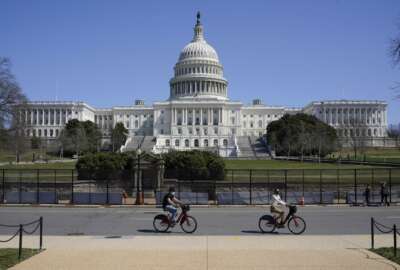
What women in the government are hoping for in the coming year
For a temperature check and look ahead, the legislative representative for Federally Employed Women, or FEW, Tonya Saunders.
Best listening experience is on Chrome, Firefox or Safari. Subscribe to Federal Drive’s daily audio interviews on Apple Podcasts or PodcastOne.
The beginning of the end of the pandemic might be in sight, but there’s no clear signs of where federal employees will be working in the future, or when they’ll be working there. In some ways, the long telecommute has been difficult for women. For a temperature check and look ahead, the legislative representative for Federally Employed Women, or FEW, Tonya Saunders, joined Federal Drive with Tom Temin.
Interview transcript:
Tom Temin: Ms. Saunders, good to have you on.
Tonya Saunders: Oh, thank you, Tom, so much. It is an honor and a privilege to be here.
Tom Temin: Let’s talk about that bill, I guess the American Rescue Plan, 1.9 trillion, whatever you want to call it, it did have some provisions for federal employees in there, very deep in there, 15 weeks of paid leave for quarantine, recovery from illness and so forth. What is FEW’s take on all of those provisions?
Tonya Saunders: Well, we’re very excited, in fact, that they did include additional paid leave, so that employees can use this emergency leave to care for themselves, their children, their spouse, and others. It’s, in fact, we were very supportive of the Federal Employee Paid Leave Act for years. And that was also passed prior to this bill. But this gives federal employees a level of comfort, particularly women, you know, Tom, women have been hit the hardest by COVID-19. And so just the name itself let you know that this is a organization of women.
Tom Temin: That gets me to a question I wanted to ask you about. In the pandemic, families have been home, federally employed women and men have all been home and kids have been home quite a bit or whatever the case might be, other family members — is it your sense that a lot of the pressure and the extra work resulting there from has sort of resorted to the old model and women are carrying greater burden in the homes while trying to do their jobs?
Tonya Saunders: Absolutely. And in fact, I hear that quite often. And you mentioned children being at home, they’re also going through school at home and the parenting responsibilities. I know that they’re more shared today than they were maybe in my time, but there’s still that caretaker/caregiver aspect to the woman being at home, and the mental stress and pressure of it all.
Tom Temin: Yeah, so then this provision will help, but so will people just getting back into offices, and especially children getting back into the schools will really have an effect on federal productivity in some strange way.
Tonya Saunders: Absolutely, particularly if it’s safe to do so. And again, women tend to be concerned a lot with how we move back into our workspaces as well as the children going back to school. And in fact, you also point to the fact that there was additional funding in there for childcare assistance, which is going to be critical to get those back up and running, because who’s going to, pick up the children from school and that kind of thing when you’re now back into the workforce. So all of that has to come back online in order to make it, I think, productive for everybody and less mental stress.
Tom Temin: Yeah, a lot of moving parts here because in some jurisdictions, the younger kids are in school, but not the older or maybe the older, but not the younger. And so it may be a little somewhat easier, but it’s not solved yet the situation. And it doesn’t look like it’s going to be really until maybe the fall.
Tonya Saunders: Absolutely, Tom. And, again, we applaud Congress and the administration for addressing the concerns from the standpoint that they could and that is with the additional financial assistance, that’s going to be very important as people try and figure all of this out. And all those moving pieces come together in some way that allow folks to get back to some new normal, I won’t say normal, but new.
Tom Temin: And one signal we have not heard much from is the agencies themselves on what their reopening plans are. Early on during the Trump administration in the early days of the pandemic, that was Level A and level B and level C and all these elaborate plans for returning, maybe nobody thought this would drag on as long as it has. But now, are you getting signals from your members or from any of the agencies as to how they plan to bring people back to the offices?
Tonya Saunders: Not yet. And in fact, as you may recall, they’re still agencies or at least cabinet heads that have to be nominated and approved through Congress. So once I believe the leadership is in place under the Biden administration, we’ll hear more. A lot of the instruction for the federal workforce comes through OPM, that’s Office of Personnel Management, then you have OMB, Office of Management and Budget. So once a lot of the positions are filled, I believe we’ll hear a lot more.
Tom Temin: And now we have Marty Walsh, the mayor of Boston is the Secretary of Labor. So he might weigh in on that because he’s got that working class kind of orientation, I think.
Tonya Saunders: I would imagine so. It’s been highlighted and all of his papers and throughout the news, so great things yet to come.
Tom Temin: Alright. And I want to ask you a bigger question. Since the Biden administration has come in, we have seen an emphasis in executive orders and activities of several large agencies so far in the whole diversity, inclusion, equity front. And this is something that they’re pushing agencies to undertake. In a sense, that’s always been a mission of federal agencies, but they feel there’s some more lift now for women in the federal workforce.
Tonya Saunders: Yes, actually I do. There has always been that has always been a focus of federally employed women. In fact, they work hard for the advancement of all women in the federal government, and all of our issues that we have supported support that.
Tom Temin: So this is a moment, in some ways, because it really is a push and an emphasis of the new administration — but these moments sometimes come and go, don’t they?
Tonya Saunders: Yes, in fact, they do. Under the previous administration, you may have noticed that there was a rollback in some cases regarding gender discrimination and other language that was being touted. But this administration now has a laser being focused on inclusivity.
Tom Temin: And what about the training issue, because that was a controversial executive order at the end of the last administration trying to end certain types of training, and I’m not sure it ever actually happened in the government. There weren’t too many examples of it, but training in not so much sensitivity, but in critical race theory and that kind of thing. What is your sense of what’s going on now with respect to diversity and inclusion training for all federal employees?
Tonya Saunders: Well, one of the focus areas of Federally Employed Women is to provide training on diversity, inclusion and non discriminatory practices. Why? Because it is a law under EEOC and the federal agencies have to be compliant to the law and understand what the law states. So that’s a large portion of what the organization does. Now, as you refer to the contractors who provide training, those contractors as I understand it have resumed because the executive order has now been rescinded. Our position as an organization, we don’t have one, in fact, on what people are using for their tools for training. But I’ll be very clear about FEW’s training program and that is non discriminatory practices under EEOC law.
Tom Temin: Got it. And what will FEW be looking at legislatively? What do you want next from Congress? What are your agenda items for the next year or so?
Tonya Saunders: Oh, Tom, that’s a great question. We have priority issues, FEW has three tiers. Tier One are issues directly impacting federally employed women. Tier two issues affecting all federal employees, regardless of gender. And then tier three issues affecting all women as a class. And there are two very important issues that are weaving their ways through Congress currently. One is the Equal Rights Amendment, ERA. The other is the Violence Against Women Act.
Tom Temin: And that’s what you’re going to be pushing lawmakers to get a stick on.
Tonya Saunders: Yes, absolutely. ERA, it’s been way too long. I believe over 90 years, or something like that. I mean, that’s more than my lifetime. Well, almost more than my lifetime.
Tom Temin: Well, you look young from what I’m seeing on video. Tonya Saunders is legislative representative for Federally Employed Women. Thanks so much for joining me.
Tonya Saunders: Oh, thank you so much, Tom, for having me.
Copyright © 2025 Federal News Network. All rights reserved. This website is not intended for users located within the European Economic Area.
Tom Temin is host of the Federal Drive and has been providing insight on federal technology and management issues for more than 30 years.
Follow @tteminWFED





